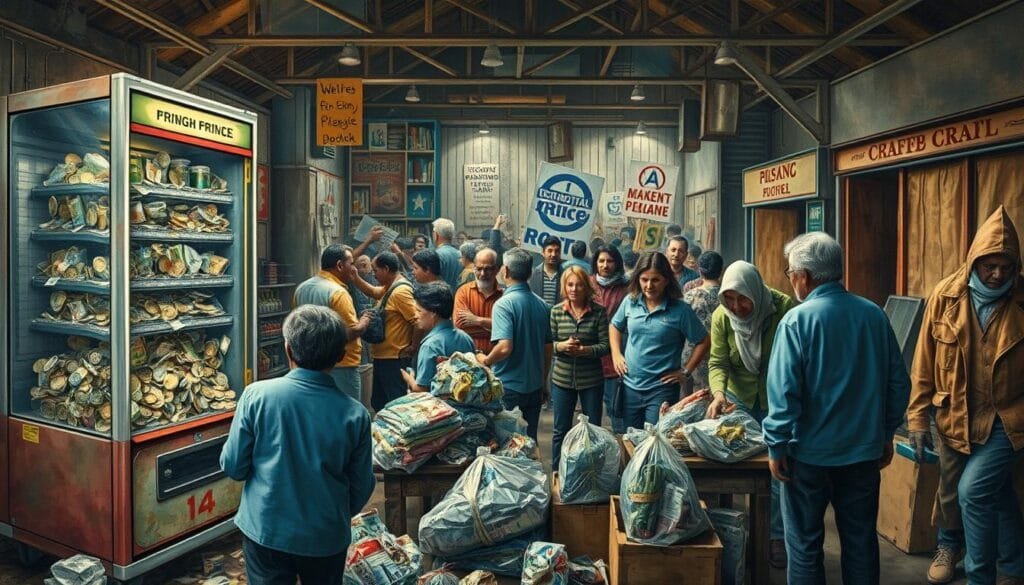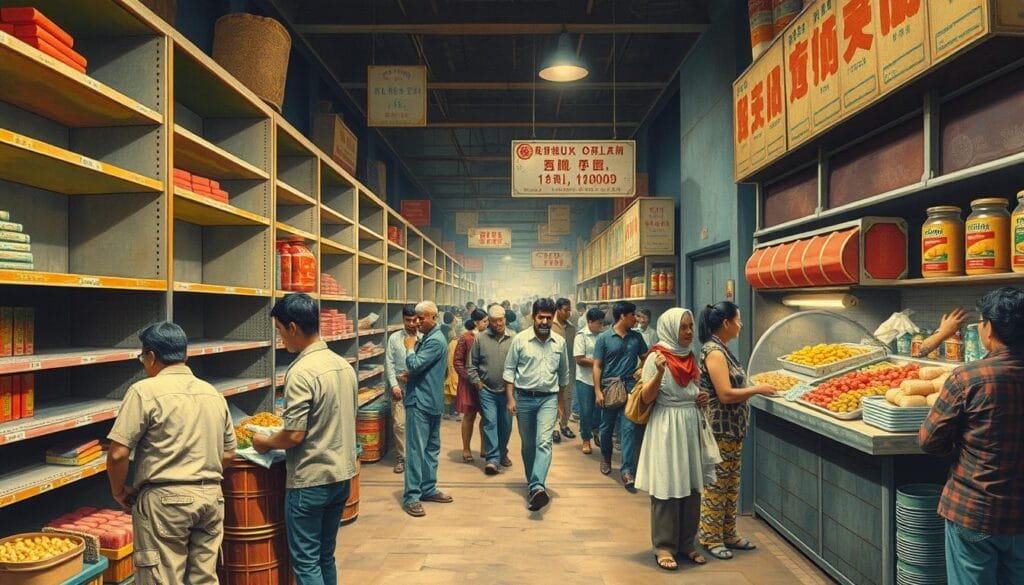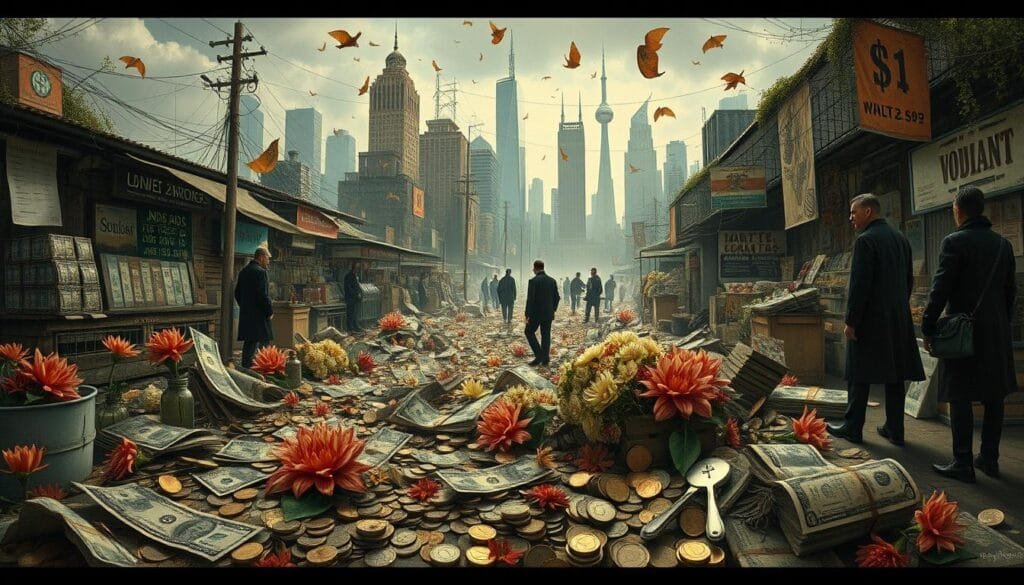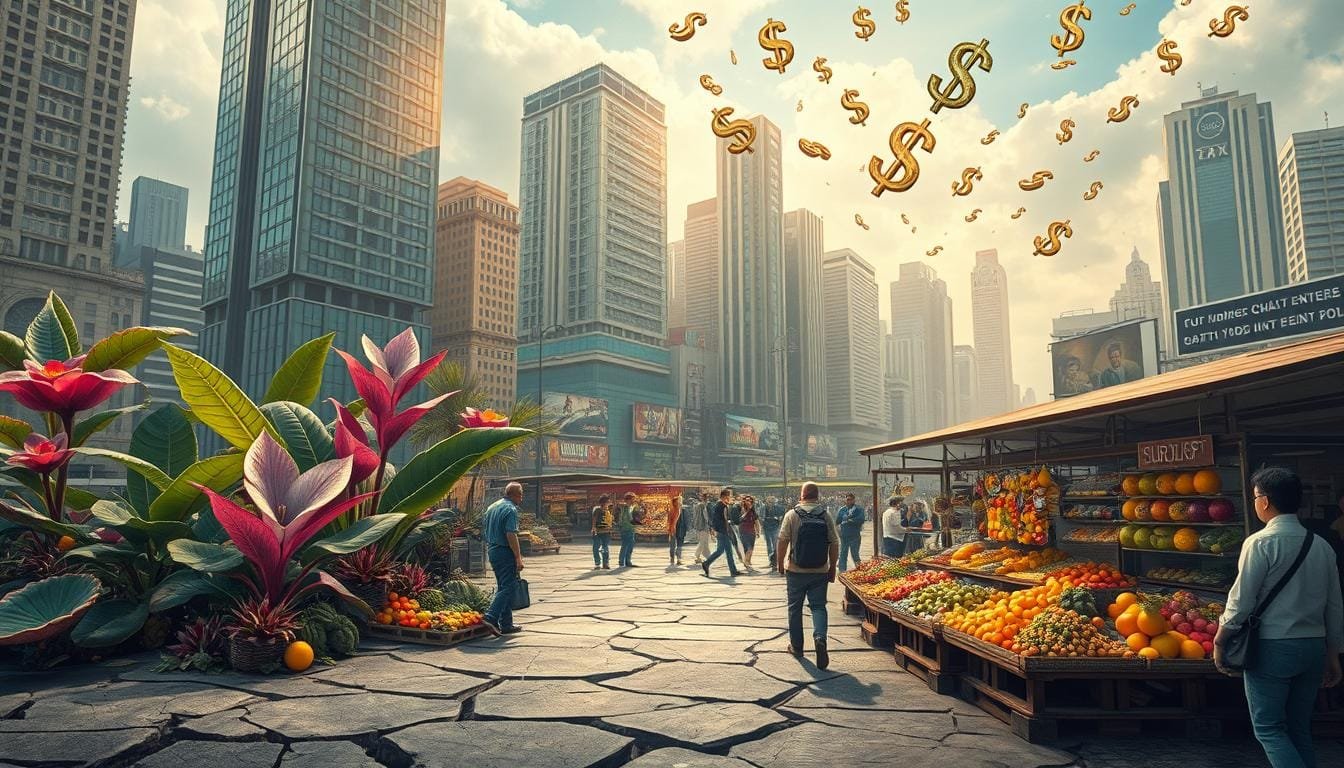Have you ever wondered why some economic policies don’t work out? Our “Guide to Economic Unintended Consequences” looks into this. We talk about how even well-planned economic moves can have unexpected results. These unpredicted effects show us the power and uncertainty of economic decisions.
Key Takeaways
- Even good policies can have surprising effects; there’s a 40% chance of something unexpected happening.
- Rent control might decrease rental homes by 25%, causing shortages.
- Taxes on sugary drinks could boost healthier drink options by 30%.
- Higher minimum wages might increase unemployment for low-skilled workers by 10%.
- In markets with constant demand, price increases hardly affect how much people buy.
Understanding Economic Unintended Consequences
Economic unintended consequences happen when attempts to improve the economy backfire. Economic theory explores these effects. Thinkers like John Locke and Frédéric Bastiat studied this idea. Robert K. Merton explained how economic actions can have unexpected outcomes.
Definition and Significance
Unintended consequences are outcomes that weren’t planned. In economics, these outcomes can be negative. Merton pointed out several causes, like ignorance and errors. These issues make it hard to predict how policies will work out.
Historical Perspectives
Historical debates have helped shape our understanding of these concepts. In 1692, John Locke criticized lowering interest rates. He said it would make it harder for people to borrow money. Frédéric Bastiat talked about the “seen and unseen” in economics. He warned that focusing only on immediate results can miss important hidden impacts.
To better understand these impacts, consider the following:
| Policy or Event | Unintended Consequence |
|---|---|
| FDA regulations since 1962 | Delayed drug introductions, increased mortality rates |
| Steel import quotas by the U.S. government | Higher steel prices, reduced automaker competitiveness |
| Minimum wage laws | 1-3% workforce reduction in small businesses |
| Agricultural subsidies | 30% production increase, market disruptions |
| Sin taxes on sugary beverages | 10-15% increase in black market activities |
This analysis shows that the impact of economic decisions can be widespread and unexpected.
Classic Examples of Unintended Consequences
Throughout history, economic thinkers have shown us something important. Policies and personal actions can lead to unexpected results. Understanding these outcomes helps us grasp the complexity of economic choices.
Adam Smith and the Invisible Hand
Adam Smith’s invisible hand theory shows the power of unintended economic consequences. In “The Wealth of Nations,” he noted something interesting. People following their own interests in a free market help society as a whole. This happens even though they don’t try to do it on purpose.
John Locke’s Analysis on Interest Rates
John Locke had big ideas about interest rates that still matter today. He believed controlling interest rates through laws would hurt more than help. Instead of making loans cheaper, these rules led to less credit available and higher costs for everyone.
Frédéric Bastiat’s Seen and Unseen Effects
Frédéric Bastiat explored the direct and indirect results of economic actions. In his essay, he talks about the Bastiat unseen consequences. He said we often ignore the long-term negative impacts of our decisions. Bastiat’s work tells us to look at all effects, seen and unseen, in policy making.
Economists like Adam Smith and Frédéric Bastiat have made an important point. Even when policies aim to make things better right away, unintended consequences might make things complex or worse. It’s a call to think deeply and look ahead in economic planning.
What are examples of unintended consequences economics
Unintended consequences are key in economic policy, leading to outcomes that surprise us. For example, back in 1692, John Locke warned about lowering interest rates from 6% to 4%. He said it would make getting credit harder, showing early on how economic regulation effects can unfold.

Price controls are meant to stabilize markets but they can backfire. Placing a price ceiling in hurricane-affected areas might make plywood suppliers hold back. This causes shortages instead of solving the crisis.
Economic regulation impacts industries deeply. Following the Exxon Valdez oil spill in 1989, states set strict laws for tanker operators. These rules, aiming to prevent spills, actually made spills more likely and made it harder to get damages—a typical policy backfire.
Regulations in the pharmaceutical sector show how complex these consequences can be. Since 1962, the FDA’s drug rules have caused delays in new drugs coming out. This has led to preventable deaths and suffering. This happened despite the rules’ goal to ensure safety for consumers.
- Price controls in hurricane zones lead to material shortages.
- Post-Exxon Valdez regulations increased the risk of oil spills.
- FDA drug regulations delayed drug introductions, causing preventable deaths.
Here is a detailed comparison of economic outcome examples and their unintended impacts:
| Scenario | Intended Effect | Unintended Consequence |
|---|---|---|
| Interest Rate Reduction (1692) | Increase Borrowing | Reduced Credit Availability |
| Hurricane Price Controls | Stabilize Plywood Prices | Material Shortages |
| Exxon Valdez Laws (1989) | Ensure Liability | Higher Oil Spill Risks |
| FDA Drug Regulations (1962) | Increase Drug Safety | Delayed Drug Availability |
From price controls to environmental laws, these economic outcome examples show that good intentions can lead to bad outcomes. They highlight why it’s crucial to do a full impact check before making policies.
Modern Examples in Economic Policies
Modern economic policies often lead to issues with price control, economic surpluses, and regulatory outcomes. These issues show up in different ways, changing how markets work. They affect both the people making products and the ones buying them.
Price Ceilings and Shortages
Government-set price ceilings below market value can cause shortages. For example, a ceiling of $10 against a market price of $20 makes some goods hard to find. This leads consumers to look for goods in unofficial markets. Price controls disrupt markets and make it hard for everyone involved to manage.

Price Floors and Surpluses
Price floors, like minimum wage laws, can lead to too many workers and not enough jobs. If companies have to pay $1000 but the normal wage is $700, it can cause unemployment. If the minimum wage goes up by 10%, unemployment might rise by 1-3%, hitting low-skill jobs hardest. This shows how well-meant policies can have unexpected drawbacks.
Regulations and Market Distortions
Regulations can sometimes twist the market in ways that weren’t intended. Environmental rules can make it 10-30% more expensive for companies to operate. These extra costs are then passed to consumers, making things more expensive. Also, higher taxes can make people less willing to work. A 10% tax hike could reduce the workforce by 0.5-1.5%. This shows the tricky balance needed with regulations.
The Role of Ignorance and Error
Ignorance and mistakes greatly influence economic decisions and unexpected outcomes. Often, the absence of deep data analysis and future planning results in outcomes no one wanted.

The launch of the Samsung Galaxy Note 7 in 2016 is a prime example. It led to a huge loss of about $22 billion because the devices kept failing. This happened because they rushed the product to market without proper tests.
The Challenger disaster in 1986 is another example of how overlooking expert advice can result in big mistakes and tragic outcomes. Another case is Johnnie Walker Black Label in Japan. A simple price change had unintended effects, making it lose its top spot as the bestselling scotch whiskey.
Marketing Tata Nano as “the world’s cheapest car” was a massive misstep. It conflicted with the Indian view of cars as symbols of status. This misunderstanding didn’t just hurt sales. It also harmed the brand’s image forever.
The falls of Kodak, BlackBerry, and Blockbuster show what happens when companies don’t evolve with technology. Sticking to the old ways and ignoring market trends caused their failures. These are clear examples of economic mistakes caused by not changing.
- Samsung Galaxy Note 7: $22 billion loss due to device failures.
- Johnnie Walker Black Label: Price reduction led to sales decrease.
- Tata Nano: Marketing as cheap resulted in poor sales in India.
- Challenger disaster: Ignoring safety recommendations led to tragedy.
- Failure to Adapt: Kodak, BlackBerry, Blockbuster faced market exit due to status quo mentality.
Below is data showing the big effects of ignoring the facts and making wrong choices in economic policy:
| Event/Entity | Impact | Key Factor |
|---|---|---|
| Samsung Galaxy Note 7 | $22 billion loss | Device Failures |
| Johnnie Walker Black Label | Sales Decline | Price Reduction |
| Tata Nano | Brand Damage | Poor Marketing Strategy |
| Challenger Disaster | 7 Astronauts Lost | Ignoring Safety Warnings |
| Kodak, BlackBerry, Blockbuster | Market Exit | Status Quo Mentality |
Government Interventions and Their Impacts
Government policies can affect the economy in various ways. It’s crucial to understand how these impacts work. This knowledge helps us see the full effects of government actions on our economy.
Fiscal Policies: Spending Cuts and Tax Hikes
Governments use fiscal policies like spending cuts and tax increases to manage debt. But, these steps can have different results. For instance, cutting government spending may slow economic growth. This is especially true for areas that rely on public funds.
Raising taxes can also decrease the money people and companies have to spend. This might lead to less investment and consumption. Overall, such actions can reduce economic activity.
Following the FDA mandate for sesame labeling, many food manufacturers opted to add sesame to their products to comply with the law. This resulted in an increase in foods containing sesame.
Social Security and Savings Behavior
Social Security aims to support the retired and disabled. It guarantees them a basic living standard. But, its influence goes beyond just providing security. It affects how people save money.
Some people might save less, expecting Social Security benefits in the future. Lower personal savings can limit investment funds. This, in turn, can slow down economic growth.
- The reduction in the average annual approvals of new chemical entities (NCEs) from forty-three (before 1962) to sixteen (after 1962) following the Kefauver-Harris amendments highlights how regulatory changes can impact innovation.
- Historical data from the Americans with Disabilities Act indicated that requirements for “reasonable accommodation” led to reduced employment rates among disabled individuals.
- OPEC managed to increase world oil prices from approximately $3 per barrel to $11 per barrel during late 1973 and early 1974, demonstrating the global repercussions of the US government’s Mandatory Oil Import Quota Program.
So, while the intent behind government interventions is usually good, their side effects must be carefully examined. This ensures we find a balance that promotes both stable growth and economic health.
Unintended Consequences in Everyday Life
Unintended consequences often pop up in our daily lives, usually from actions meant to do good but end up surprising us. These effects can be grouped into two types: those we see coming and those we don’t.
Household Chores and Incentives
Paying kids for chores is common. It aims to teach them responsibility. But, this can bring unexpected economic twists.
Children might only do chores for money. This shows how rewards can change their willingness to help in ways we might not expect.
Workplace Dynamics
The same goes for work. Not paying for overtime can accidentally create expectations for more work without extra pay. This hurts how employees feel and shakes up economic stability.
Workers may need to find other ways to make money or spend less. This is due to the higher demands at work.
| Aspect | Intended Action | Unintended Consequence |
|---|---|---|
| Household Chores | Monetary Incentives | Reduced Willingness to Help without Pay |
| Workplace Dynamics | Unpaid Overtime | Increased Workload Expectations |
Conclusion
The idea of unintended consequences shows how complex economic systems can be. When we look at these consequences, we see that good intentions don’t always lead to good results. For example, after the Exxon Valdez oil spill, laws were changed. This ended up hurting smaller companies that had lower safety standards.
This shows us that we need to think carefully about how policies are made. Another example is the rent control in London. It made some landlords less interested in offering homes for rent. This led to fewer houses available for people to live in.
To really understand economic results, we need to look at the big picture. Looking back at history and current events helps. For instance, the Common Agricultural Policy (CAP) tried to help farmers by setting minimum prices. But this led to too much food being produced and upset other countries.
Adding roads to reduce traffic can actually bring more cars to the area. This doesn’t fix the traffic problem; it just moves it. These examples show why we must keep checking and tweaking policies. This way, they can work better and last longer.
It’s key to see and plan for unexpected results when making economic policies. By studying both the past and present, we can get better at making policies. Those policies should have more benefits and fewer downsides. Full understanding of how things are connected in economics helps in making sound policies.
FAQ
What is meant by economic unintended consequences?
Unintended economic consequences are outcomes we didn’t expect. They can come from any economic action or policy. They affect many parts of the economy, not just the areas they aimed to help or change.
Why are unintended consequences significant in economic analysis?
Unintended consequences show the complexity of economic policies. They make us think about all possible results. This helps to plan better and understand the economy’s wide-ranging effects.
What are some historical perspectives on unintended economic consequences?
Famous economists like Adam Smith and John Locke talked about these consequences. Their insights help us see how unexpected outcomes have always influenced economic thought.
How does Adam Smith’s invisible hand illustrate unintended consequences?
Smith’s invisible hand theory says self-interest can unknowingly help society. It’s a classic example of how personal goals can lead to general benefits without intending to.
Can you provide examples of unintended consequences in modern economic policies?
Modern examples include price ceilings causing shortages and regulations leading to market distortions. These show that good intentions in policymaking can sometimes have negative side effects.
What role do ignorance and error play in unintended economic consequences?
Mistakes and not knowing better can lead to unexpected bad outcomes. This tells us why it’s crucial to analyze economic policies well and make informed choices.
How do government interventions impact the economy through unintended consequences?
Government actions like tax changes or social security updates can have varied effects. They change how people save or spend, sometimes in unpredictable ways.
What are some unintended economic consequences observed in everyday life?
In daily life, things like chores can change incentives, and office dynamics can affect how people work. This shows economic concepts and surprises are everywhere, even at home or work.
